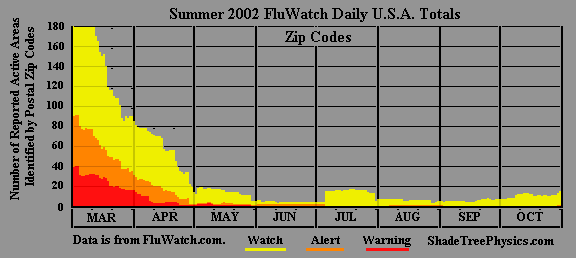USA Influenza Activity Summer 2002
Latest text/format update 22 December 2004.
(This info was originally in the USA Influenza 2002-2003 page.)

The Summer "Bump"
See the two-frame-loop that shows the FluWatch.com active areas on 4 and 5 July 2002. (Frame alternations occur every three seconds.) The nine zip codes with new activity, which "popped up" on 5 July, are circled in red.
Perhaps, even more important than the comet's closest point of approach, is that back on 29 March 2002, plus or minus a few days, the comet's tail may have been in direct contact with Earth's atmosphere. That event would have preceded the 5 July surge of U.S. influenza activity by three months and a week. See the graphs of FluWatch activity for 2000-2001 and 2001-2002 and note the "surge" in "Alert" activity around the 29th of March 2002. That particular surge may be more likely related to a trans-Pacific dust storm from Asia. See: U.S. landfall of big Asian dust storm a washout.
(While viewing the flu activity graphs, check out the "Alert" surge that occurred in early April of 2001. That surge coincided with the arrival of the 2001 trans-Pacific dust storm.)
To really put oneself out on a limb, it is suggested that what looks like a post season surge in flu activity, which began on 2 May 2002, was the initial result of the comet contact of 29 March, and that two months later (5 July) some of the alien drop-ins (in eight states) got themselves repaired enough to do some serious damage. The idea is that the comet-to-Earth journey is "rough" on the viruses (radiation damage primarily) and that it takes a few months (two months in this case) for them to recuperate to their full battle-strength. (Added 23 September 2002 - Modified 28 Sep 2002 and 25 Oct 2002.).
No specific virus strain information is currently available to connect the 2002 flu activity surges (end of March, 2 May, and 5 July 2002) with the comet or the dust storm. The ZymeTx rapid throat swab tests (on which this analysis is based) are not strain specific and the CDC doesn't generally publish findings during the summer months. (Modified 25 October 2002.)
"In mid-July 2002, Madagascar health authorities were notified of a substantial number of deaths attributed to acute respiratory illness (ARI)... The Madagascar Ministry of Health (MOH) and the Intitut Pasteur, Madagascar (IPM) initiated an investigation, which found an attack rate of 70% for ARI, with 27 deaths in Sahafata" Quoted from: CDC MMWR for November 15, 2002 [Three separate areas were hit with influenza like illnesses]. The Madagascar outbreaks may have had a global connection with the 05 July 2002 splatter of influenza activity in the United States, as discussed above. (Added 04 December 2002.)
Notes on Long-Distance Dust Storms
*Electrical charges are the real actors. Magnetism can be viewed as a conceptual by-product of charges in motion.
Excess electrical charge which penetrates a planet's atmosphere should eventually spread out over the planet's surface. Where a fraction of this excess charge builds up in desert regions, dust and perhaps "hibernating biotic forms" can be electrically lifted into the atmosphere. Normal air movements can then carry the dust and microbes for long distances. (Until it is bled off, the excess planetary charge will tend to keep the traveling combination airborne.) See the 17 July 2001 comments by Bruce Kite, of Columbus Mississippi, and the 1 August 2001 comments by Amy Acheson, of Seattle, Washington, in the Global Developments, Spring - Summer 2001 section. (Added 25 October 2002.)
The ZymeTx, Inc. rapid throat swab test, used as a basis for FluWatch reports, checks for influenza A and B, but does not differentiate them. FluWatch uses the following levels of flu activity in a given area. Watch: Positive flu results have been reported. Alert: Positive flu results are being reported as consistently as every other day in moderate numbers. Warning: Positive flu results are being reported consistently on a daily basis in high numbers. Epidemic: Flu is widespread in the area.
Recommended Web Pages.
[Added 22 Dec 2004.]
Hidden piece of influenza virus protein found - Sci Tech - The Hindi - Online edition of India's National Newspaper, Thursday, Dec 13, 2001.
Influenza Terms Glossary - FluSTAR.com
Home | Up one level | Previous | Next
Top